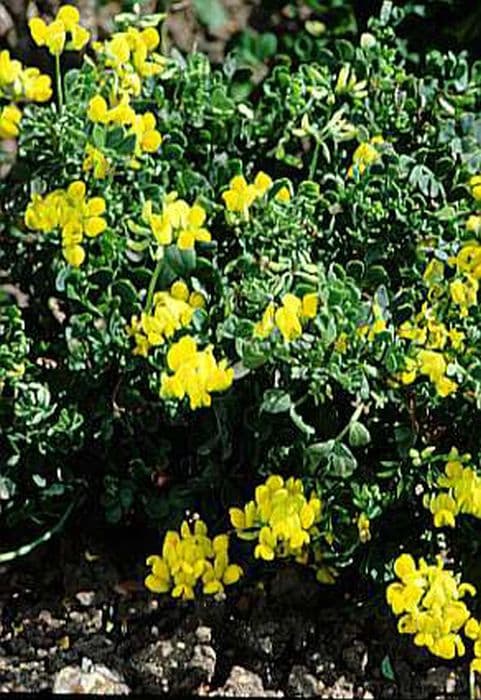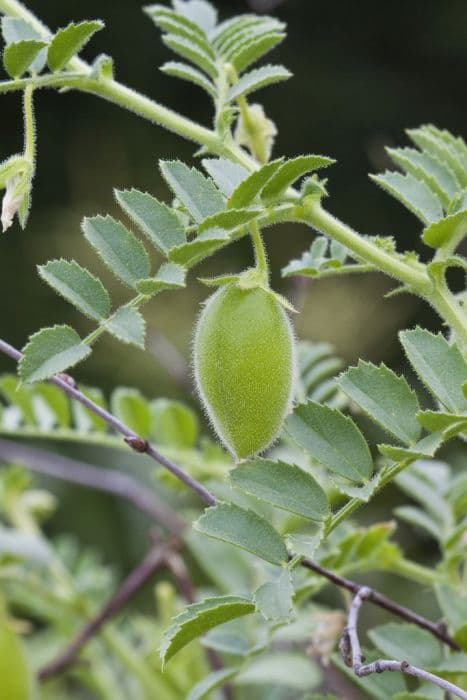Kentucky Coffeetree Gymnocladus dioica

ABOUT
The Kentucky coffeetree is a unique deciduous tree known for its rough, scaly bark and large, bipinnately compound leaves. These leaves are among the largest of any native tree in North America and can create a tropical appearance during the growing season. The foliage is bluish-green in color, turning to a warm yellow in the fall before dropping off for winter. The tree's branches are stout and strong, often appearing awkwardly spread out, which gives the tree an almost skeletal look in the wintertime. Its name is derived from its seeds, which are contained in hard, leathery seedpods. These seedpods, typically dark brown and resembling large beans, hang off the branches and can persist into the winter months. Each pod encases a few seeds that were historically used as a coffee substitute, hence the common name. Male and female flowers are typically found on separate trees. The male flowers are insignificant, clustered in greenish-white panicles that hang from the branches. Female trees produce the more noticeable, greenish flowers that evolve into the large, long seedpods. With its unique and bold appearance, the Kentucky coffeetree is a striking, sculptural element in the landscape during all seasons.
About this plant
 Names
NamesFamily
Fabaceae.
Synonyms
Kentucky Coffeetree, American Coffeetree, Stump Tree, Nicker Tree, Mahogany-Bean.
Common names
Gymnocladus dioicus, Guilandina dioica, Gymnocladus canadensis.
 Toxicity
ToxicityTo humans
The Kentucky coffee tree contains toxic compounds, which can be harmful if ingested by humans. These compounds are particularly concentrated in the seeds and to a lesser extent, in other parts of the plant, such as the leaves and bark. When consumed in large quantities, the seeds can cause symptoms including nausea, upset stomach, vomiting, and diarrhea. In severe cases, it might lead to more serious health issues such as difficulty breathing, convulsions, or coma. Therefore, it is important to handle the seeds with care and ensure they are not consumed by children or adults.
To pets
Kentucky coffee tree can also be toxic to pets if ingested. Similar to humans, the most toxic parts of the plant are the seeds, with the leaves and bark containing lower levels of toxins. If a pet consumes the seeds or large amounts of other parts of the plant, they may exhibit symptoms such as vomiting, diarrhea, lethargy, and abdominal pain. In more severe cases, ingestion can cause tremors, difficulty breathing, or even seizures. Pet owners should therefore keep their animals away from the seeds and other parts of this tree to prevent the risk of poisoning.
 Characteristics
CharacteristicsLife cycle
Perennials
Foliage type
Deciduous
Color of leaves
Green
Flower color
White
Height
60-75 feet (18.3-22.9 meters)
Spread
40-50 feet (12.2-15.2 meters)
Plant type
Tree
Hardiness zones
4
Native area
North America
Benefits
 General Benefits
General Benefits- Ornamental value: The Kentucky coffeetree has a unique and striking appearance, with coarse, rough bark and a skeletal branch structure that can be especially striking in the winter landscape.
- Shade provision: Its large leaves form a dense canopy that provides substantial shade, which can be appreciated in parks or large garden areas.
- Drought tolerance: Kentucky coffeetrees are known for their ability to withstand periods of drought once established, making them ideal for xeriscaping or in areas prone to water scarcity.
- Urban resilience: This species is tolerant of pollution and compacted soil, making it a good choice for urban environments.
- Wildlife support: The tree’s seedpods provide food for various wildlife species, while its branches offer perching and nesting sites for birds.
- Erosion control: With its strong root system, the Kentucky coffeetree can help prevent soil erosion in certain landscapes.
- Fall color: It offers aesthetic value in the fall when its leaves turn a vivid yellow, adding to the seasonal interest of a garden or landscape setting.
 Medical Properties
Medical Properties- This plant is not used for medical purposes.
 Air-purifying Qualities
Air-purifying QualitiesThis plant is not specifically known for air purifying qualities.
 Other Uses
Other Uses- Gymnocladus dioica, commonly known as the Kentucky coffee tree, has been historically used to produce a substitute for coffee by roasting its seeds, giving the tree its common name.
- The wood of the Kentucky coffee tree is highly valued for its fine grain and resistance to splitting, which makes it an excellent choice for woodworking and cabinetry.
- Dye obtained from the tree's bark and roots was used by Native Americans for coloring textiles and other materials.
- The large, woody seedpods have been used in crafts and as educational tools to teach about tree and seed pod identification.
- In landscaping, the Kentucky coffee tree is valued for its bold, architectural appearance and is often planted as a shade or ornamental tree.
- Its long, bipinnate leaves can be used to add a tropical-like aesthetic in temperate garden designs.
- The rot-resistant nature of the heartwood makes it suitable for outdoor uses such as fence posts and outdoor furniture.
- The seedpods, when dried and hollowed, have been used to create whimsical rattles or musical instruments in various cultural crafts.
- In permaculture, the tree's deep root system is exploited for its usefulness in controlling erosion and breaking up compact soils.
- Because of its late bud break, the Kentucky coffee tree is less prone to spring frost damage and can be used in urban planting to overcome varying climate conditions.
Interesting Facts
 Feng Shui
Feng ShuiThe Kentucky coffeetree is not used in Feng Shui practice.
 Zodiac Sign Compitability
Zodiac Sign CompitabilityThe Kentucky coffeetree is not used in astrology practice.
 Plant Symbolism
Plant Symbolism- Protection: Gymnocladus dioica, commonly known as the Kentucky coffee tree, is known for its strong structure and protective canopy, symbolizing shelter and safety.
- Patience: The tree has a slow growth rate, which makes it a symbol for patience and the value of slow, steady progress.
- Independence: The Kentucky coffee tree can thrive in harsh conditions, representing self-reliance and resilience.
- Uniqueness: With its distinctive, stout branches and bipinnately compound leaves, this tree symbolizes individuality and standing out from the crowd.
 Soil
SoilThe ideal soil mix for the Kentucky coffeetree (Gymnocladus dioica) should be well-draining and rich in organic matter, with a pH range of 6.0 to 7.5 to support its growth.
 Repotting
RepottingKentucky coffeetree (Gymnocladus dioica) is typically planted directly in the ground and does not require frequent repotting; adjust planting space as the tree matures.
 Humidity & Misting
Humidity & MistingKentucky coffeetree (Gymnocladus dioica) is tolerant of a wide range of humidity levels and does not have specific humidity requirements.
 Suitable locations
Suitable locationsIndoor
Not ideal for indoor growth due to its large size.
Outdoor
Plant in full sun, well-draining soil; water deeply, but infrequently.
Hardiness zone
3-8 USDA
 Life cycle
Life cycleGymnocladus dioica, commonly known as the Kentucky coffeetree, begins its life cycle as a seed, which normally requires stratification to break dormancy. After stratification, the seed germinates in spring, giving rise to a seedling with a deep taproot, which is crucial for survival and drought resistance. The seedling grows into a juvenile tree, a stage characterized by rapid vertical growth and the development of compound leaves that provide photosynthetic energy. As the tree matures, it enters the reproductive stage, where it develops dioecious flowers—separate male and female flowers on different trees—typically after reaching 5 to 10 years of age. Following pollination, female trees produce large seed pods containing seeds, which, once mature, are dispersed by gravity, water, or animals. The Kentucky coffeetree then continues its life cycle through repeated seasons of growth and reproduction, with individual trees capable of living upwards of 100 years under favorable conditions.
 Propogation
PropogationPropogation time
Spring to Summer
The Kentucky coffee tree, or Gymnocladus dioica, is often propagated through its seed, particularly in the fall after the seeds have ripened. The most popular method involves collecting the seed pods and then extracting the seeds from the pods. Before sowing, the thick seed coats require stratification to break their dormancy, typically involving a cold treatment for 1 to 3 months. This can be done naturally by sowing the seeds outdoors in the fall or by artificial cold stratification in a refrigerator. Once stratified, seeds are sown in a well-draining medium at a depth roughly three times the diameter of the seed, which usually equates to about an inch (2.54 cm), and they generally germinate in the following spring. Germination rates are variable, and some patience might be required, as it can sometimes take up to a full year for seeds to sprout.




![Kowhai [Sun King]](/_next/image?url=https%3A%2F%2Fplants-admin.emdemapps.com%2Fimages%2Fplants%2F%2Fimages%2F604b57cb7f598.png&w=640&q=75)



